If you’re visiting Lisbon in late spring, early summer, you’ll have the chance to see something truly spectacular at the Carmo Convent. The Carmo Convent is already a pretty astonishing place, but from May to July, when the sun sets, there is a phenomenal transformation which it undergoes. This phenomenon is called ‘Lisbon Under Stars‘. In 2018 over 30,000 people came to see this award-winning show and in 2019 those numbers should almost double since they added another month onto the performances dates due to its overwhelming popularity. I was lucky enough to see the show when we were travelling to Lisbon this summer. I was really blown away by the performance and the technical ingenuity it took to bring the whole piece together.
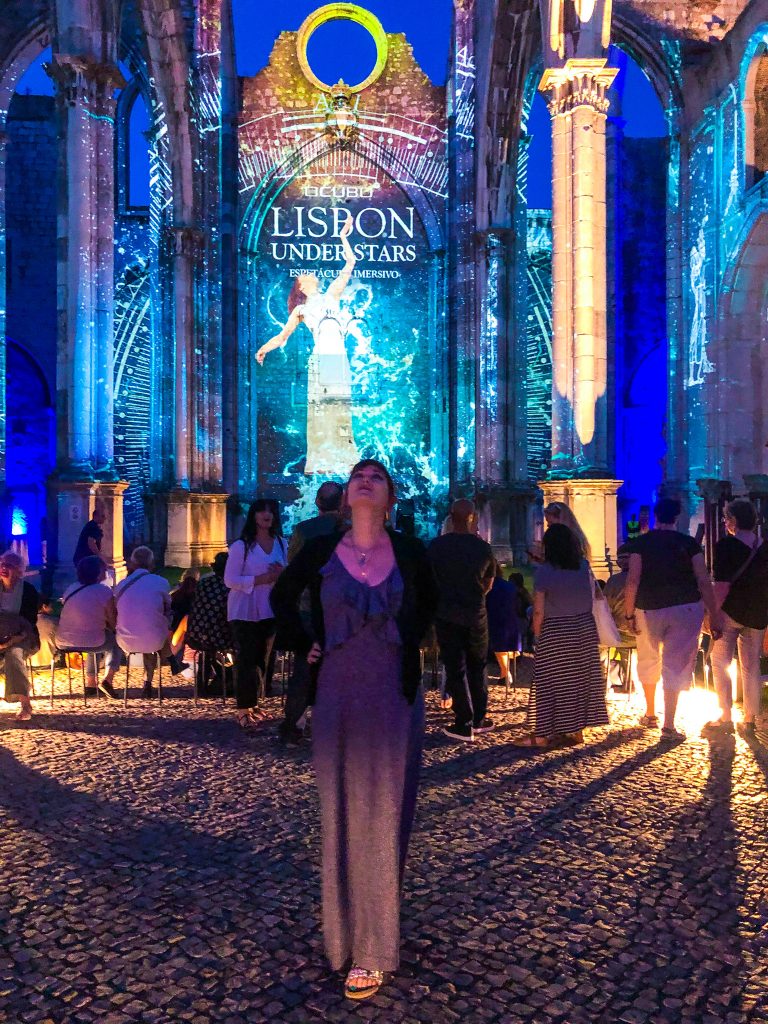
What is ‘Lisbon Under Stars’?
Lisbon Under Stars is called an “immersive and multidisciplinary spectacle” which aims to tell the story of Lisbon’s history through a mesmerizing visual performance. The entire show takes place inside the ruins of the Carmo Convent. But it doesn’t just happen inside the ruins, but the show is actually projected onto them! The multimedia projections are cast onto the remains of the convent walls and arches. Covering them like a painting, but one which moves bends and turns the space from a two-dimensional surface into a three dimensional trip back in time.
The 600 years of history steeped within the city of Lisbon is brought to life through these projections and told through the eyes of the convent itself. The convent is given a personality and embodied by a single female dancer. All the dancers were also filmed, and their performances have been woven into the multimedia projections. The dancer’s expressions and movements set against the powerful historical events help convey to the audience, wordlessly, the feelings and emotions the city was thrown into during those times. The visuals help us see through their eyes what it must have looked like during that time to be here in Lisbon. Parts of the show are narrated, and the spoken words are in both Portuguese and English, but the images are so compelling that words are almost unnecessary.
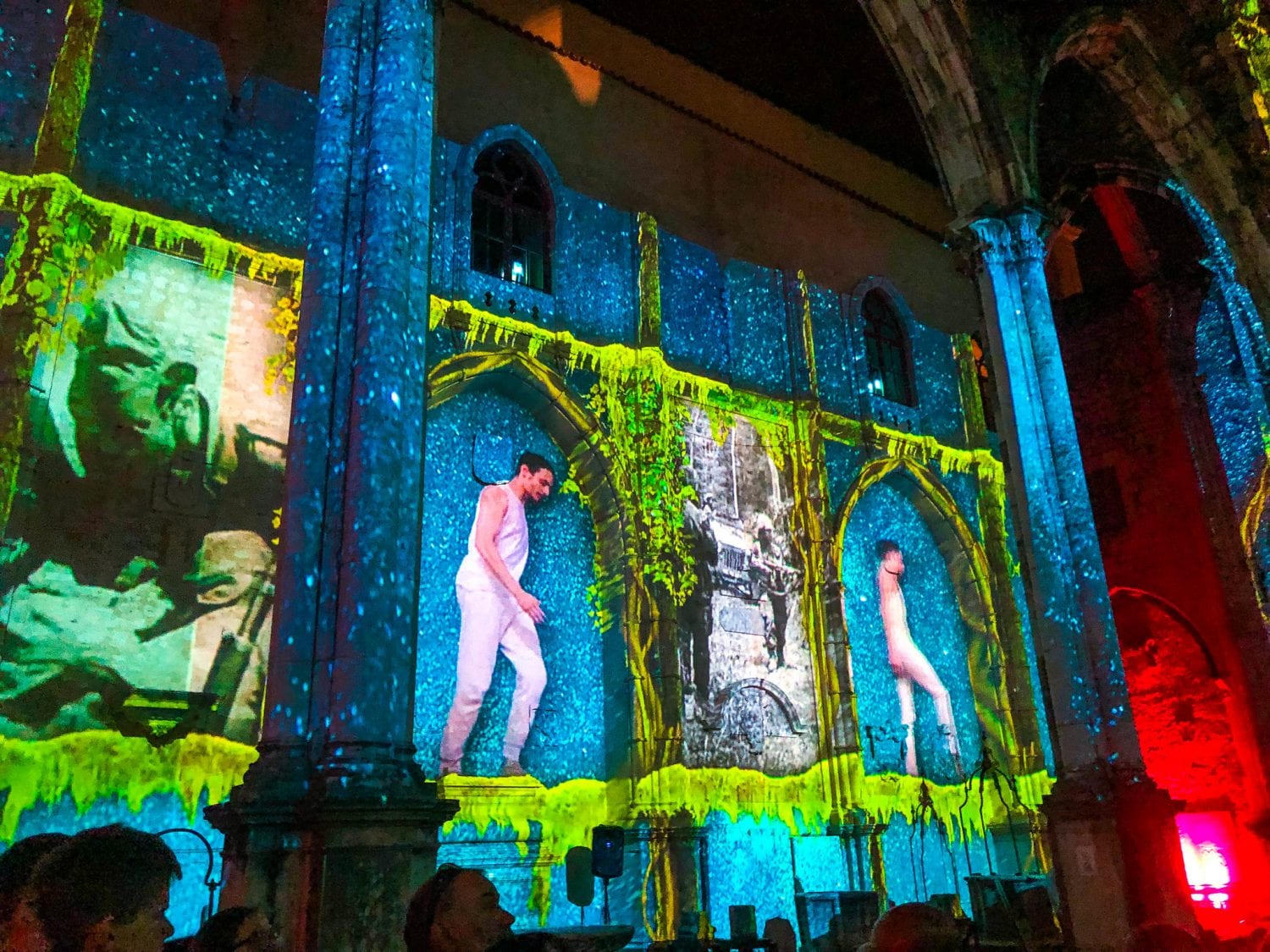
All the dancers featured in the show are from Clara Andermatt‘s Company and National Ballet. Despite the dancers not being there in real life, still interact with the space around you, even as the walls are transformed throughout the show. They react to this shifting world and truly bring another level of dynamism to the show.
Another critical aspect of making the viewer feel like they’re really embedded into the performance is the music. The entire show is set to a beautiful soundtrack performed by famous Portuguese names such as Rão Kyao, Teresa Salgueiro and accompanied by the Symphonic Chorus Lisboa Cantat, Symphonic Orchestra of GNR and Tocá Rufer. There are also a few iconic Fado songs performed by the Queen of Fado, Mariza.
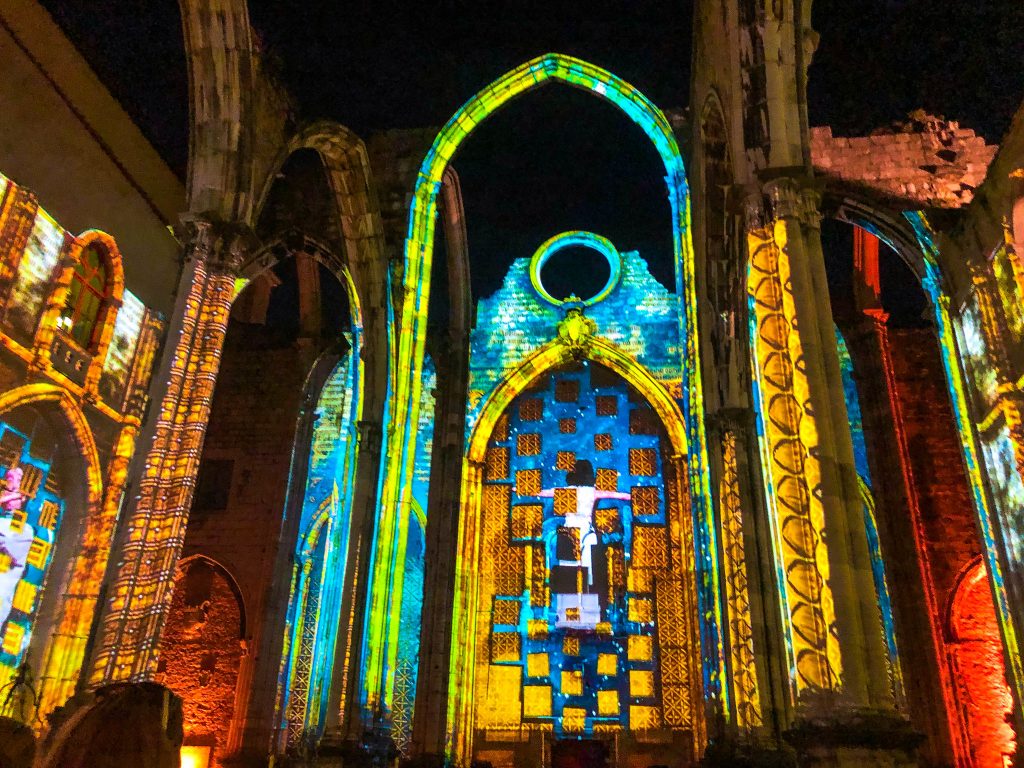
Where to Find ‘Lisbon Under the Stars’
The Carmo Convent plays host to ‘Lisbon Under Stars‘. You can find the Carmo Convent in one of my favourite little town squares, aptly named ‘Carmo Square’. The Carmo Convent is located in the Chiado neighbourhood, just up the hill from Rossio station. Right outside the convent are one of those iconic drink kiosks, the perfect place to grab a ginja under the Jacaranda trees before or after the show.
About the Carmo Convent
Instead of a stage or a traditional venue, this show takes place inside the ruins of the Carmo Convent. The ruins were once the site of the Catholic Convent of ‘Our Lady of Mount Carmel’. The convent was built in 1389 in the traditional, yet restrained, Gothic style which was synonymous with religious orders of the time. The great rose window over the portal was one of the most awe-inspiring parts of the church before it’s destruction. The great earthquake, fire and flood of 1755 caused immense damage to the building, collapsing the entire roof, leaving the interior open to the sky above.
Due to a multitude of reasons (most of which you’ll discover throughout the show), the convent was left in disrepair. The rest of Lisbon was restored to its former glory or rebuilt in a newer style, so the stark ruins of Carmo were one of the only reminders, to this day, of that great earthquake. Eventually, the convent found a new life and was transformed into the Carmo Archaeological Museum. Despite its new modern role, the structure was left untouched, a living example of Gothic architecture. Some parts of the building were given some structural reinforcements, but for the most part, the building looks as it would have hundreds of years ago, albeit without a room. Inside you can see all different archaeological discoveries which tell the story of Portugal’s history.
Times & Tickets
There are two shows per evening, at 9:30 pm and 10:45 pm. Tickets cost €15 for adults, children from 6 to 11 years, 65+ and students cost €12.50 and children under 5 are free! Tickets are available at the booth next to the Carmo Convent. We quickly were able to grab tickets right before the show and didn’t need to purchase them online or in advance. The space inside is so vast that there really isn’t a bad seat in the house, so no need to arrive super early either. There are stools available for senior or people with disabilities. Don’t be shy asking for one if needed but don’t take one if you don’t require it.
The best place to sit is right in the middle since you have the best view of the walls around you as well as the front portion of the church where some of the main scenes take place. During the show, you are free to move around the convent instead of having to stay in one place. In my experience at other immersive multimedia performances, I found that walking around actually translated into seeing the show in a new perspective. But here I found that sitting in once spot and turning your head was sufficient enough. I think that creating more spaces to explore would really enhance the experience, something they can focus on for next year!
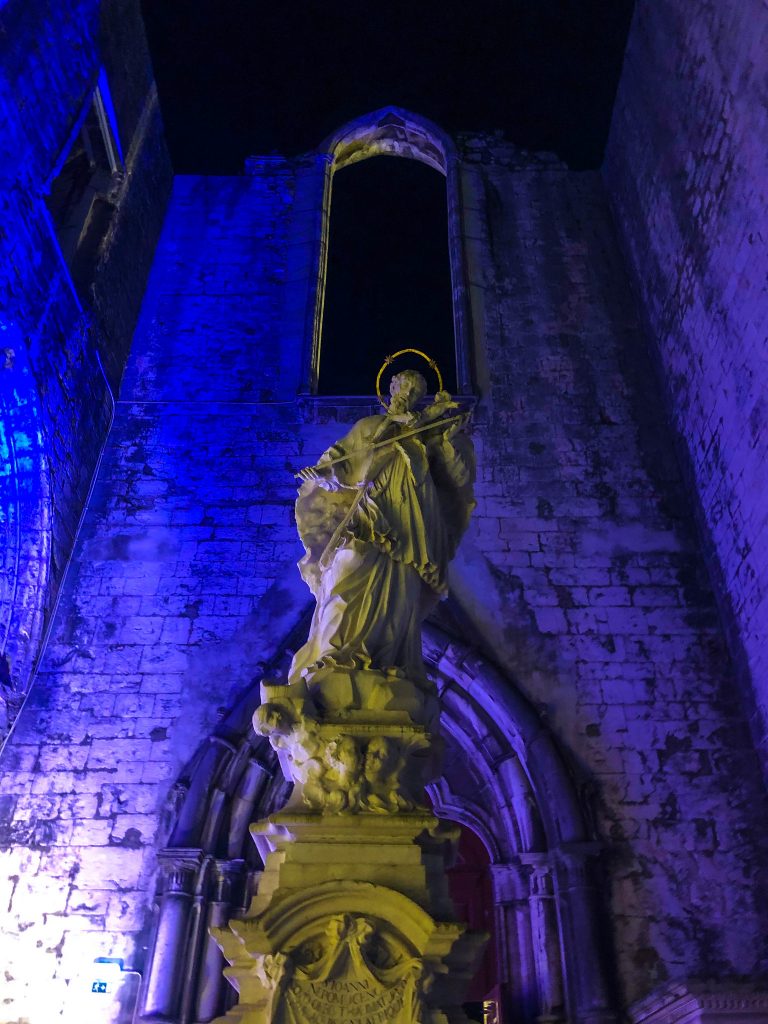
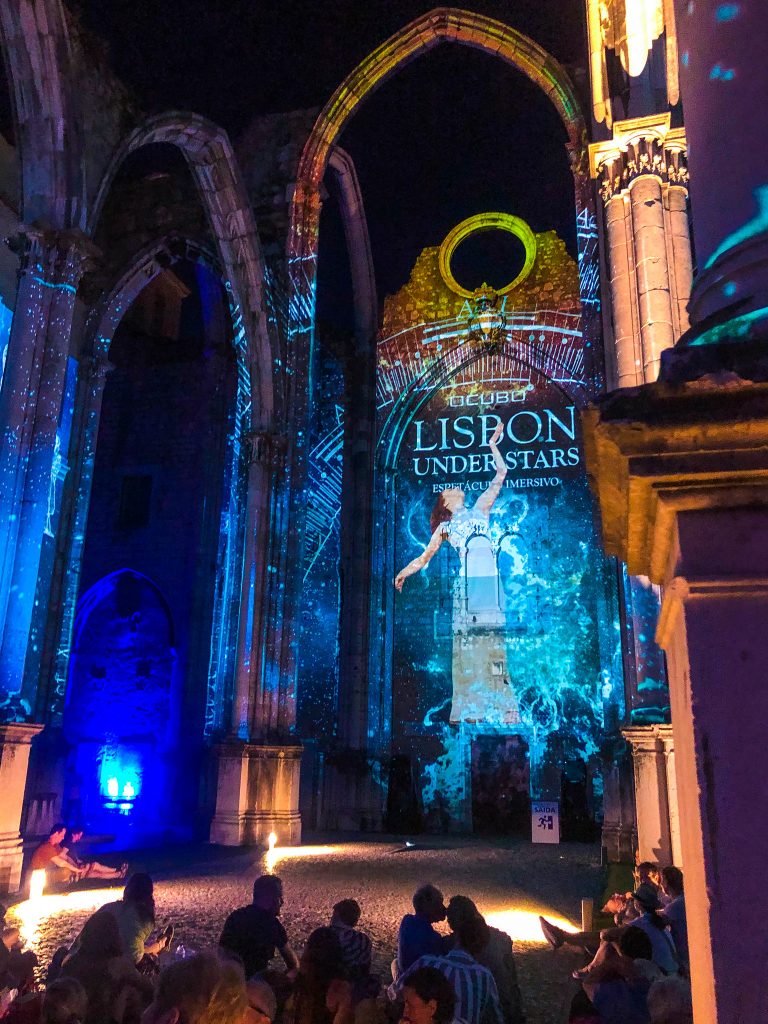
My Experience at ‘Lisbon Under the Stars’
I have seen a few different examples of these types of projections throughout my travels, and I find that they’re always so inventive and astounding. They transform spaces and turn a dull wall into a work of art. Other multimedia shows I’ve seen were only projected onto a flat surface. At ‘Lisbon Under Stars’ the visuals interacted with the three-dimensional church making it an entirely more complex installation. It really brought the entire place to life. And being outdoors, literally under the stars, just made the show feel more raw and authentic.
While some parts of this show are a little cheesy (the cheap wigs were my biggest complaint), all-in-all the show is fun and wildly creative. If you don’t know anything about Lisbon’s history, it’s such a great introduction to the city’s past. And the cost, I think, is perfectly lined up with the experience you’ll get. It’s a fun little thing to do in the evening, and it would be awesome if you’re travelling with kids.
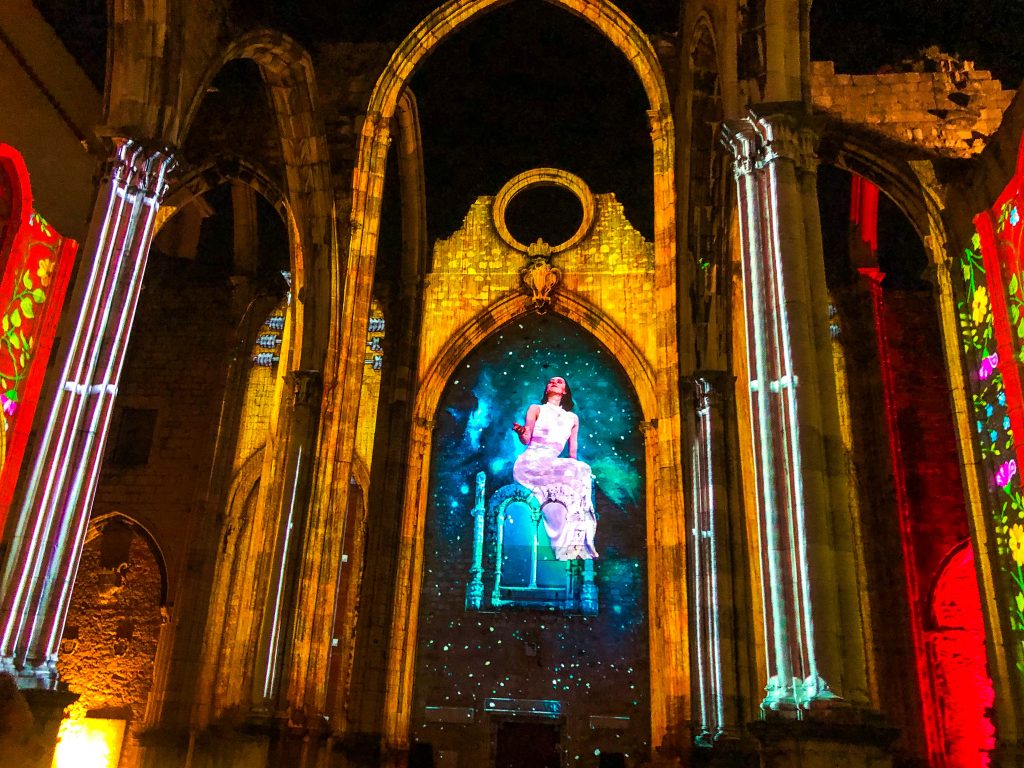
The show begins with the introduction of the women we will come to know represents the spirit of the Carmo Convent. She will be our guide throughout the show and is truly the best of the dancers. She manages to give a cold and unmoving building emotion and a fierce personality which we can relate to. We can see and feel the effects of history on her face, and by the end of the entire show, it feels like she is an old friend.
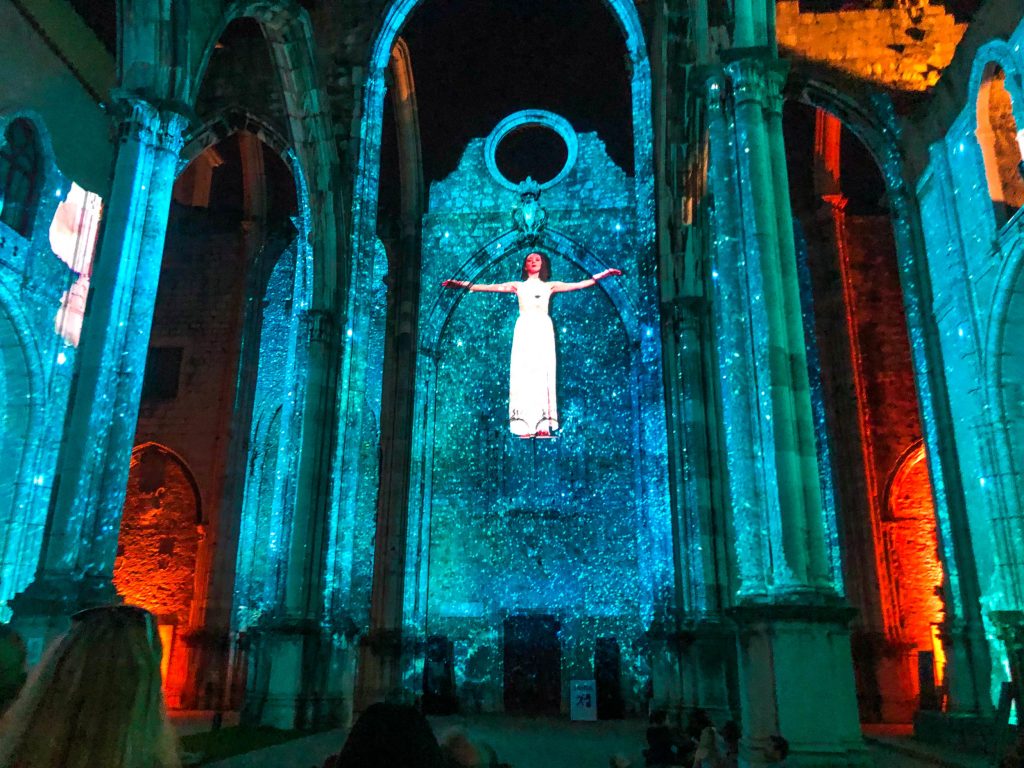
The first scene from history we see depicts the great Battle of Aljubarrota. The Battle of Aljubarrota is represented by two men dance-fighting to illustrate the great war between the Kingdom of Portugal and the Crown of Castile. This battle was so significant since it was the moment in which Portugal showed it’s dominance over the country and asserted itself as a force to be reckoned with across Europe. I will say, I wish they had skipped this part or at least re-did the choreography. I think authentic fighting from 1385 is a little strange to watch from a 21st-century perspective and it does seem to drag on a bit. It’s one of the cheesiest parts of the show which doesn’t make excellent use of the fantastic projections. So it kind of felt like instead of starting with a bang, they began with a dud.
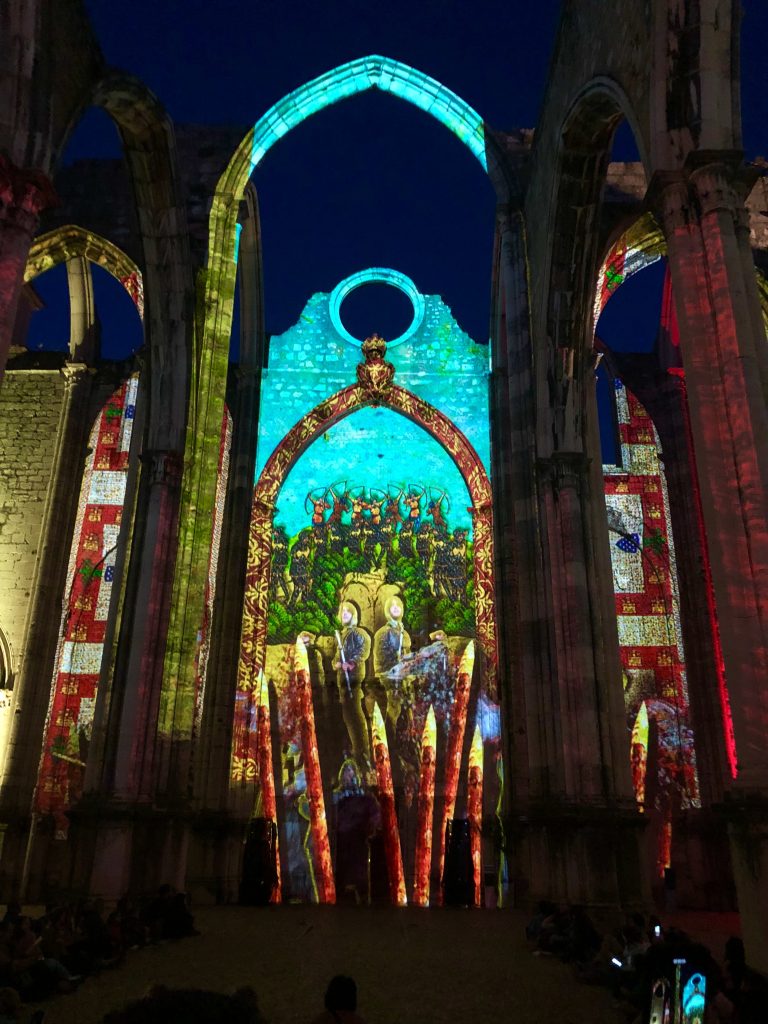
After that initial introduction, I was a bit concerned about what the rest of the show would be like. The following scene depicts the construction of the Carmo Convent in 1389. Musicians playing medieval instrument pop up all around you, playing a rhythmic tune as the walls of the convent begin to manifest in front of your eyes. The darkened walls appear to be magically being restored, bricks stack one upon the other and suddenly the true glory of the entire convent, as it once would have appeared when it was first built, reveals itself to you. So many parts of this show really feel like getting into a time machine, and this is perhaps the most impressive one. From this point forward, I had no more doubt and was entirely enraptured.
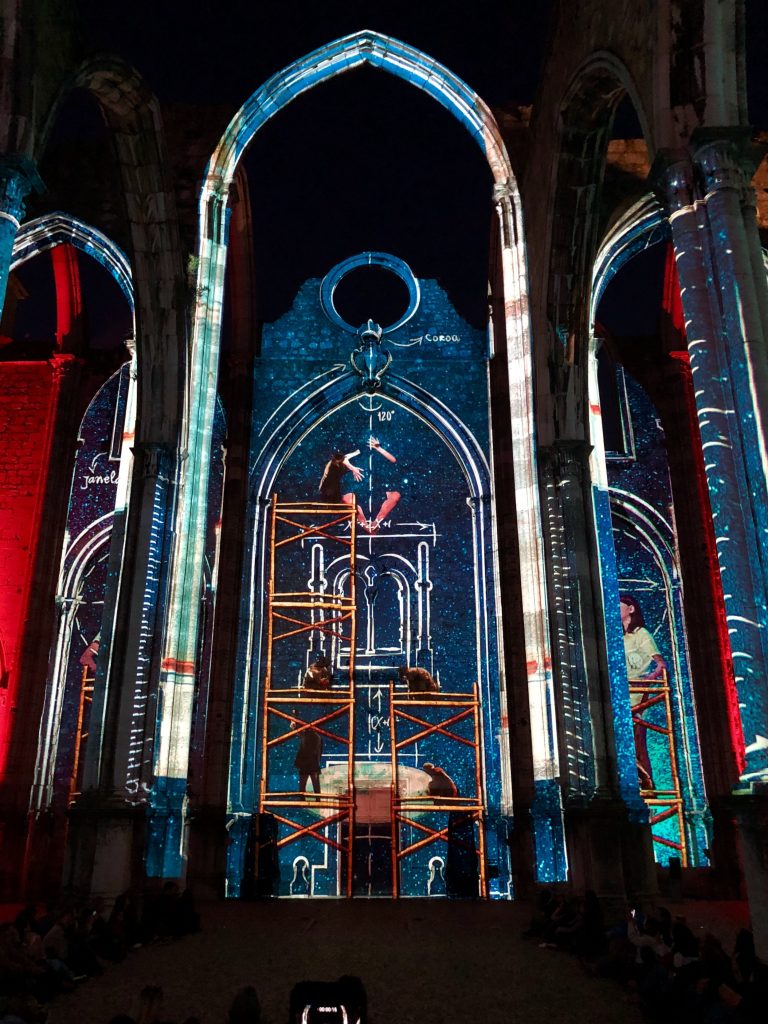
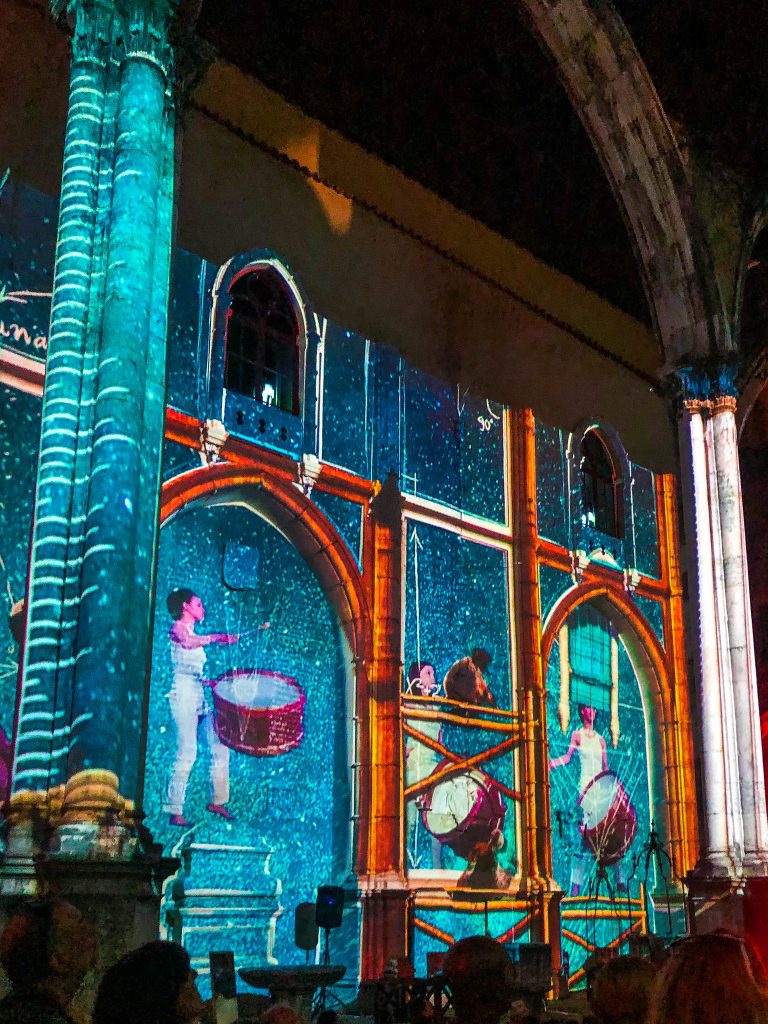
The convent and the church played a hugely important role in the collection of books and spreading knowledge to the people. The first Portuguese writers and their manuscripts are shown across the walls and books fly around the space, opening their secrets up like doves wings as the scatter.
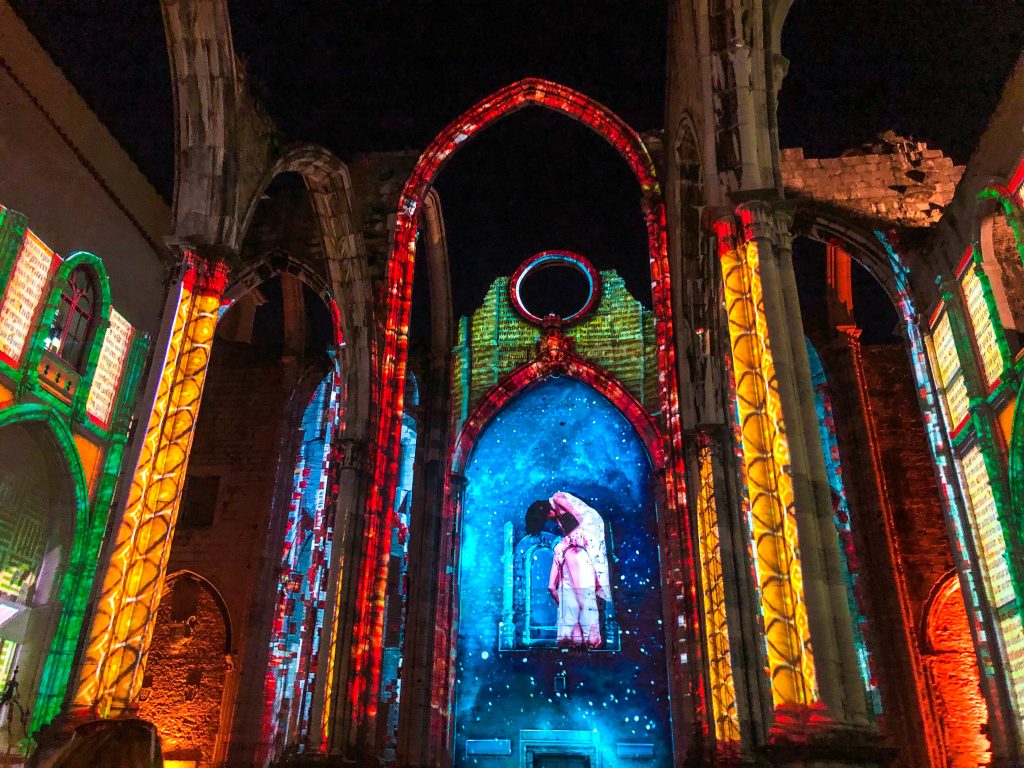
The walls begin to appear to bob and weave, and before you know it, you are stepping onto a huge ship, setting sail for the new world. This is the great maritime voyage of Vasco da Gama in 1497 which departed Lisbon in search of the sea route to India.
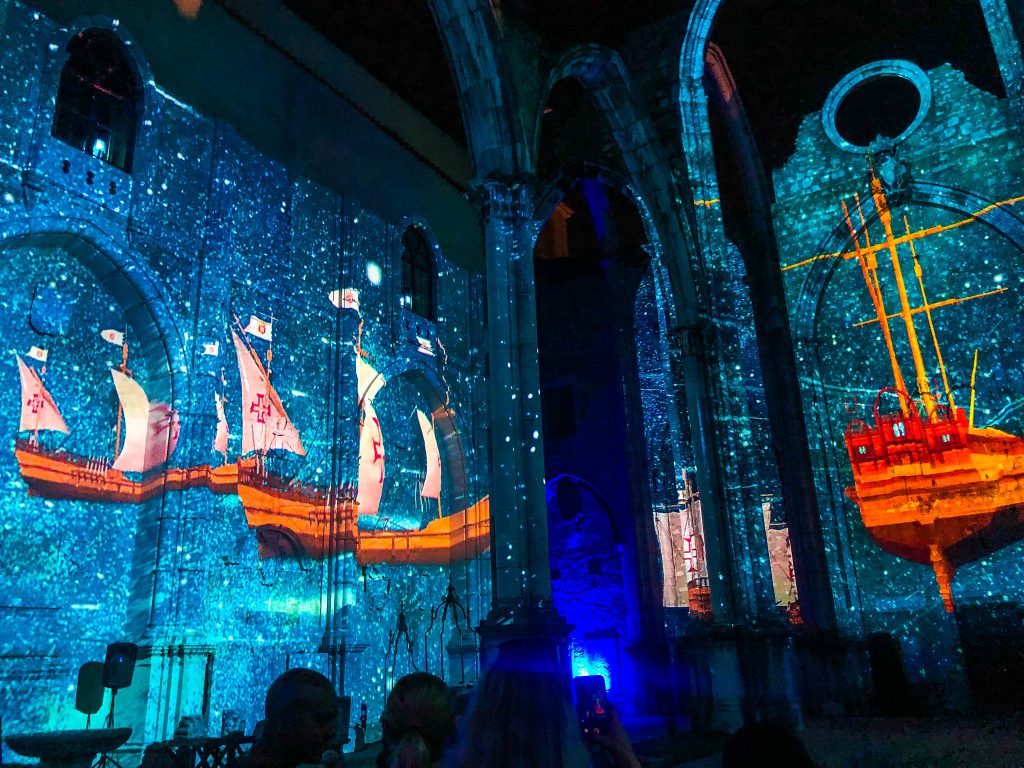
Vasco da Gama succeeded in his attempt to find it, and once there he brought back spices, textiles, animals and more home to Portugal. Trade is where a vast majority of Lisbon’s wealth came from, and the richness of that voyage comes to life here before you. We are transported through the projections, to the ports of India. We can hear and see all the brightly coloured fabrics and foods which would have stunned Portuguese importers at the time as they stepped off the boats into this strange and beautiful new land.
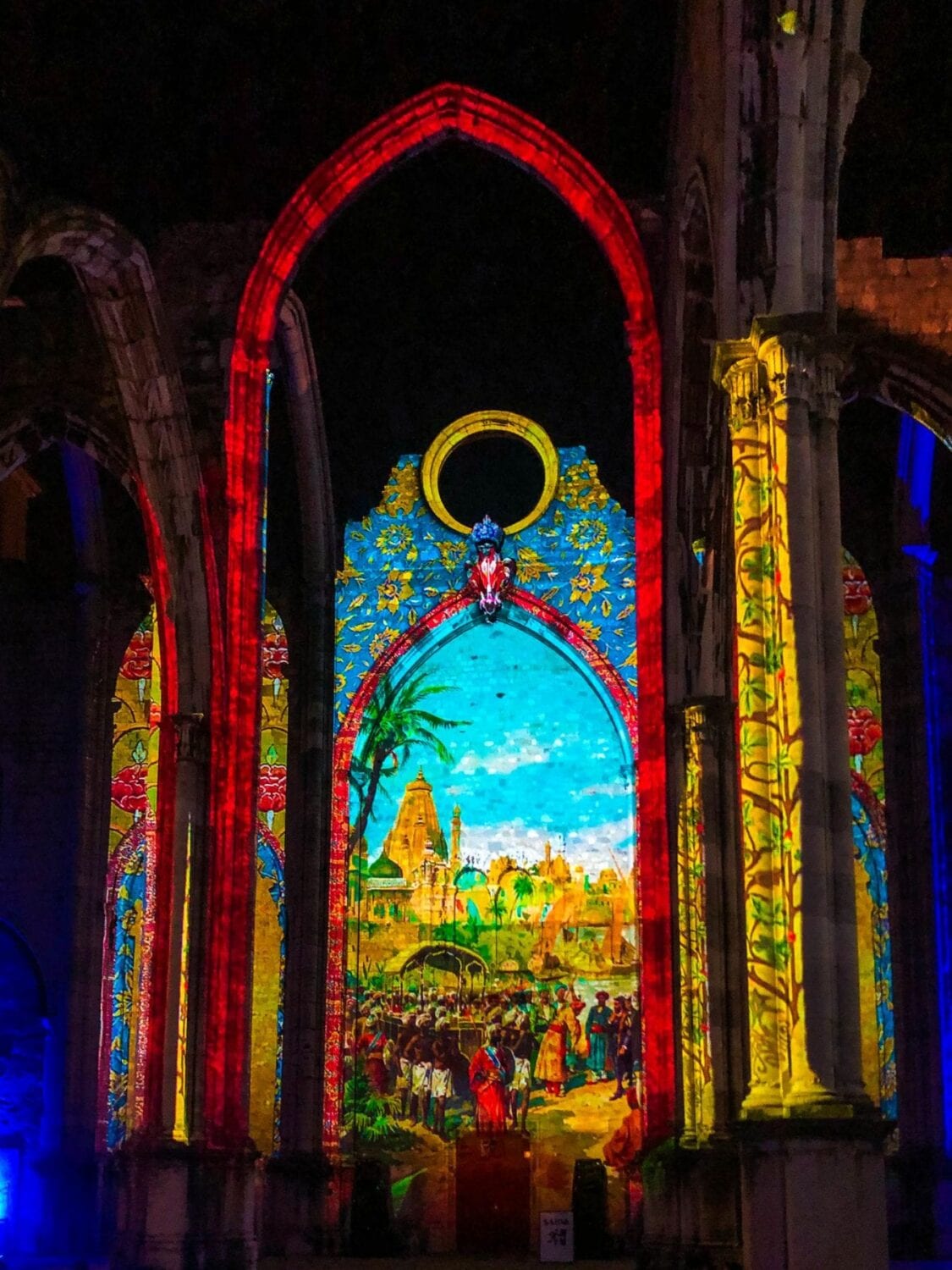
The years past and Portugal was thriving. It seemed like this city was unstoppable. And yet, on November 1st, 1755, an earthquake shook the town and brought destruction, unlike anything anyone has ever seen before. This scene throws us right into the action, the earthquake shakes the interior of the convent and beams, archways and bricks begin to fall. So lifelike you feel like you need to duck to avoid getting hit! The music booms and it feels like you’re right there! A fire breaks out and destroys what the earthquake left behind, the convent is in ruins with fires burning all around, but it’s not over yet…
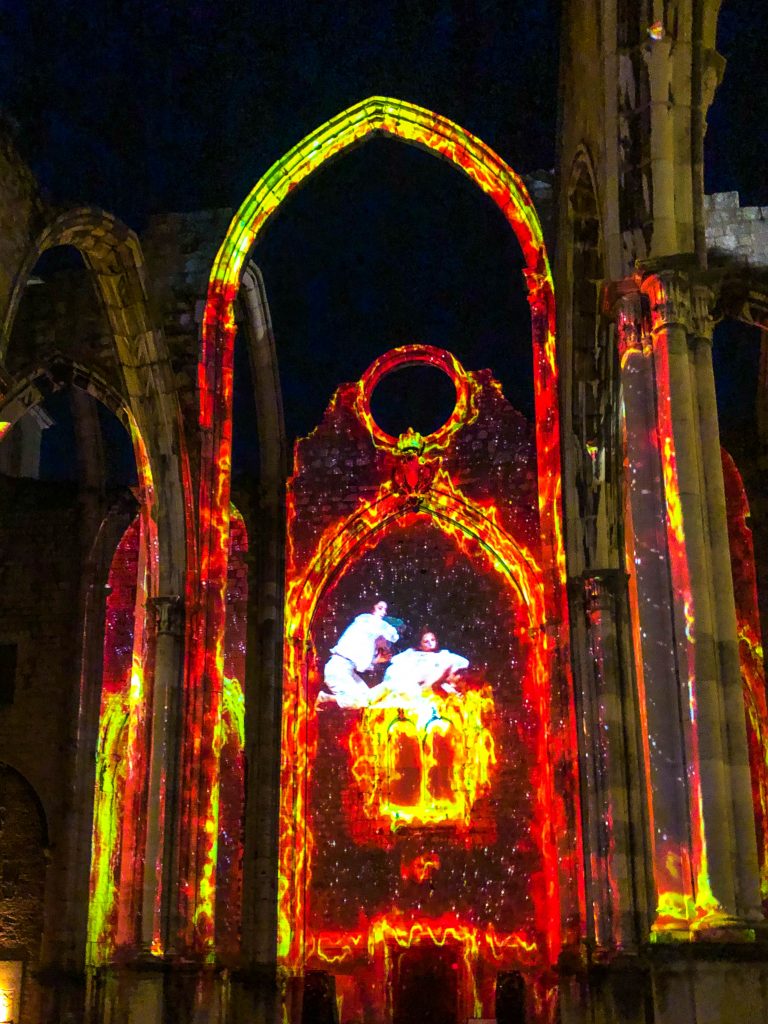
The fires begin to burn away and just when you think the worst is behind you, a great rush of water swells over the convent walls. This was the tsunami which followed the earthquake and literally swallowed most of the city. The dancers are now submerged underwater and swim like fishes across the empty blue expanse. This part was so lifelike, you could almost feel the weight of the waves crashing down on you. It was like magic.
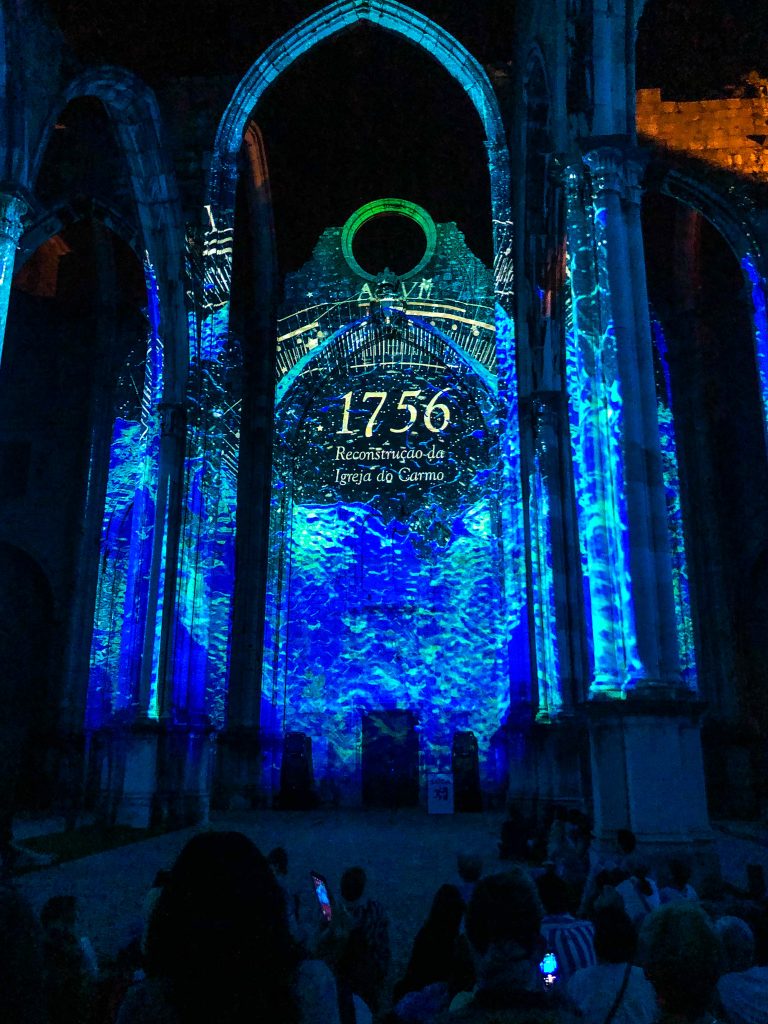
After the earthquake, there were many attempts to reconstructed the convent, but they all were in vain, for lack of funding, commitment or even just manpower. In 1835 Joaquim António de Aguiar, the prime minister of Portugal and minister of justice, was hell-bent on the extinction of religious orders. On May 39th, 1834 he created a law which extinguished “all convents, monasteries, colleges, hospices and any other houses of the regular religious orders”. This resulted in his famous nickname “O Mata-Frades” (the Friar-Killer). With the dissolution of the monks, the convent’s reconstruction was halted for good, and the church once more fell into ruins, left for the sands of time. The words of Joaquim António de Aguiar are spread across the walls of the convent like he was writing its death warrant.
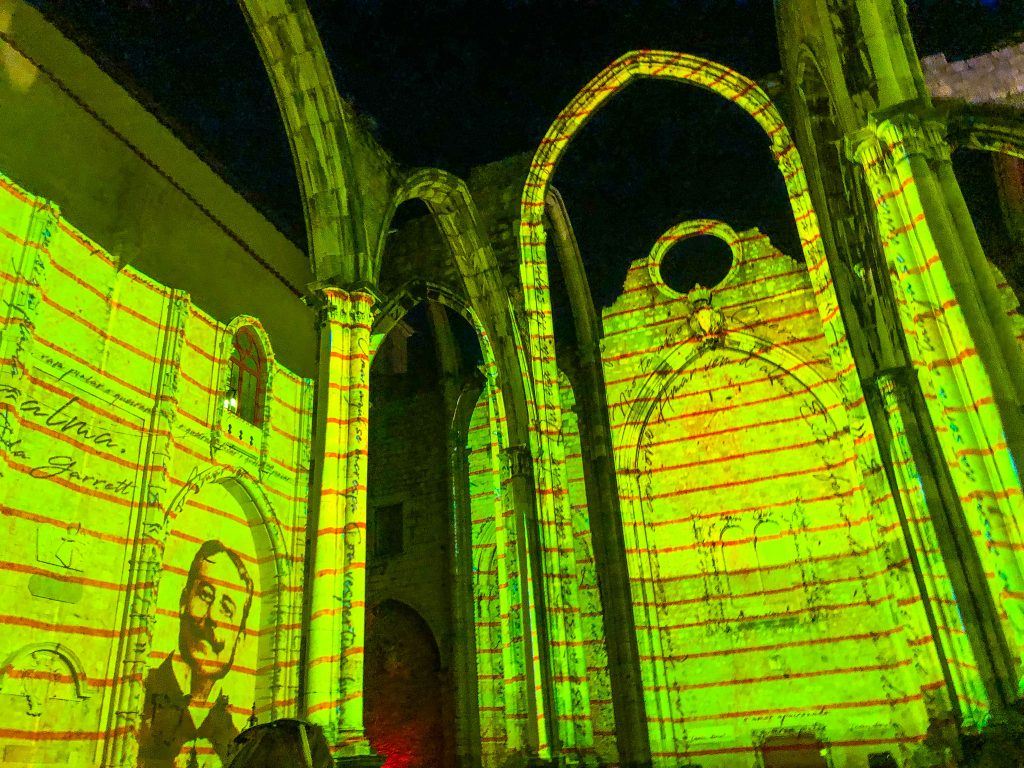
Time goes one, and all-around Lisbon things were changing…all except for the convent itself. Carmo remained a ruined memory of the earthquake’s destruction. Everywhere you looked, there were new modern inventions and exquisite architecture being constructed, and yet the convent sat untouched. The iconic tiled walls which Lisbon is famous for begin to be plastered all across the convent walls, almost like they represented the modern era overshadowing the past.
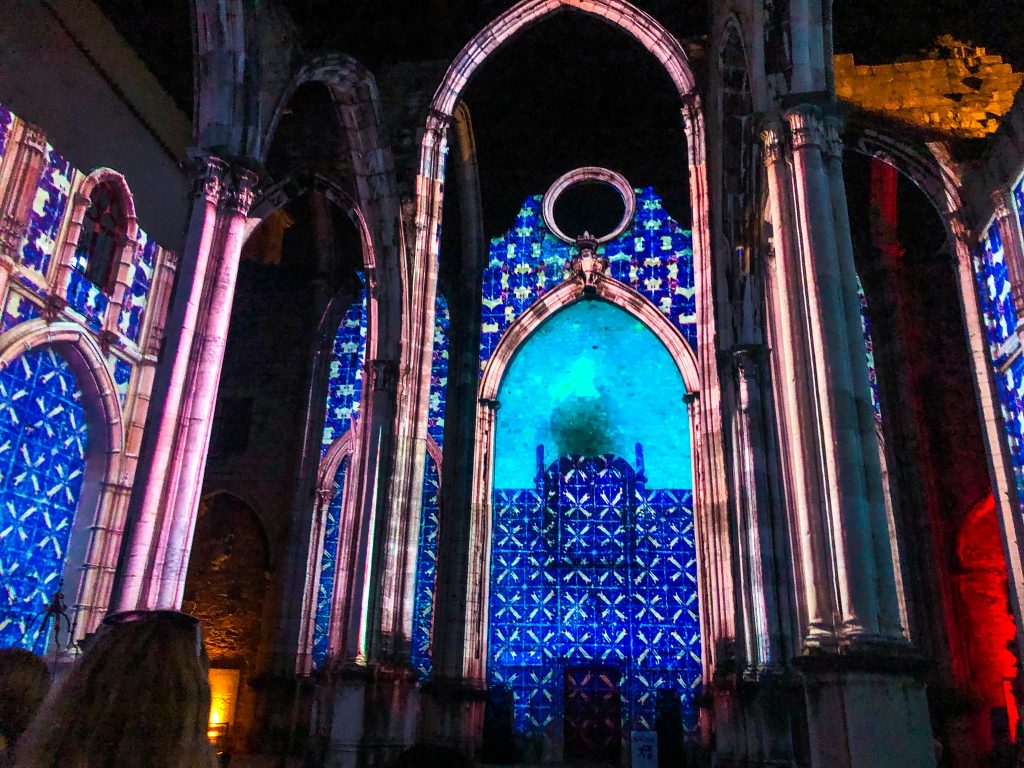
In the 1820’s we saw the emergence of Fado music into the mainstream. Fado music played in the background as the walls were covered in the traditional floral, tasselled shawls which the singers usually wear during performances. Fado music can best be described as mournful music. The Portuguese word ‘saudade’ which means ‘longing’ perfectly encapsulates the feelings which Fado attempts to explain. The lyrics in Fado songs often revolve around the life of the poor. The songs are filled with resignation and melancholia, and yet they are so beautiful it’s hard to imagine they’re about something so dark.
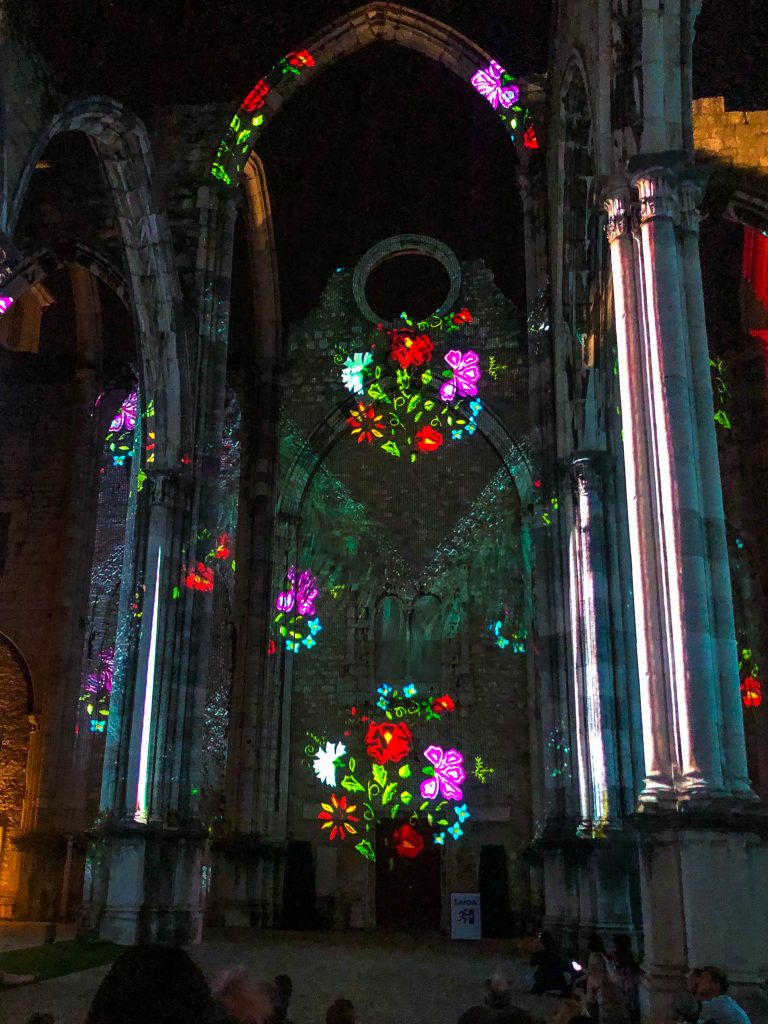
In this portion of the show, we are entertained by the music of famed Fado singer, Mariza. She performs a stunning ballad, surrounded by stars projected against the walls of the convent. If you take this chance to look up, on a perfect night, you’ll also see the stars shining above you as well.
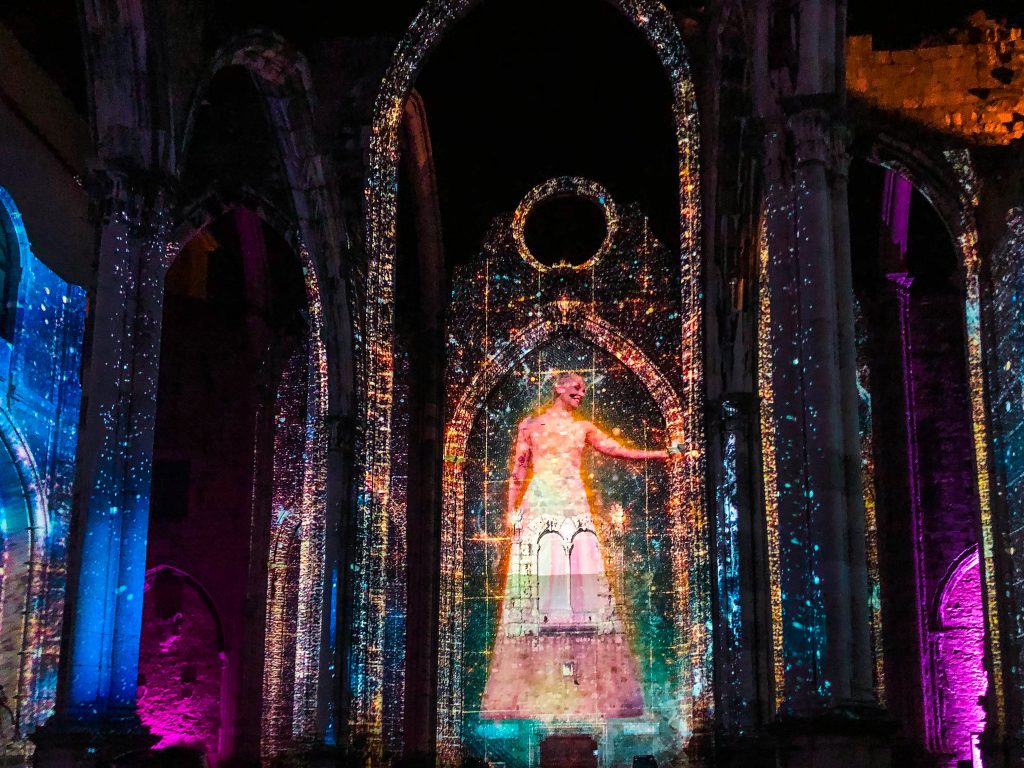
The sad Fado music seemed to be the ideal soundtrack for the soul of the convent at this time. She was alone, abandoned and lonely. She performs a last melancholic dance, her swan song, as a last attempt to have the world see her once more. Although things seem lost for her in 1864, something happens to pull her out of the darkness of the past. In 1864 convent was converted into the Archaeological Museum of Lisbon. In here, thousands of treasures from antiquity were collected and displayed for the viewing pleasure of the public. Now the convent is filled with people all the time, and the woman is no longer lonely anymore.
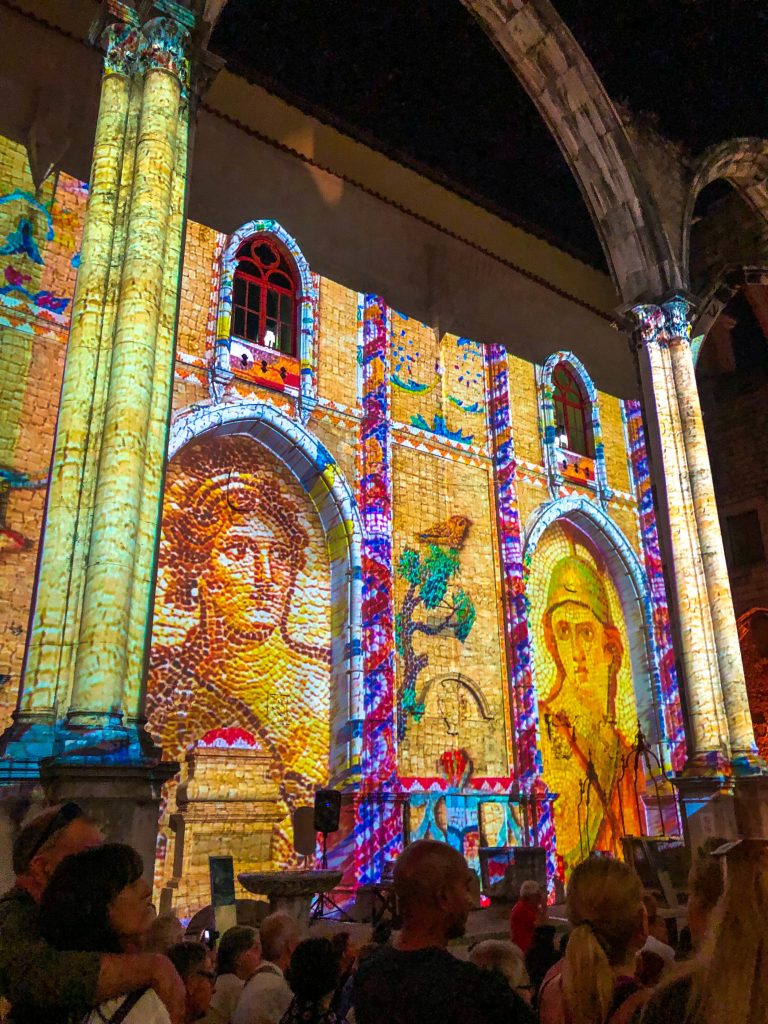
The modern era comes in with a bang! Contemporary art explodes all over the walls. The colours so bright and vibrant they come to life even without the animations. The most impressive works of art were from Amadeo de Souza Cardoso, one of the most famous Portuguese modern artists. Amadeo de Souza Cardoso was influenced both by cubism and by futurism. His colours are so vivid they seem almost aggressive, and yet there is always a nuanced balance to his paintings, which ensure they don’t feel chaotic or confused.

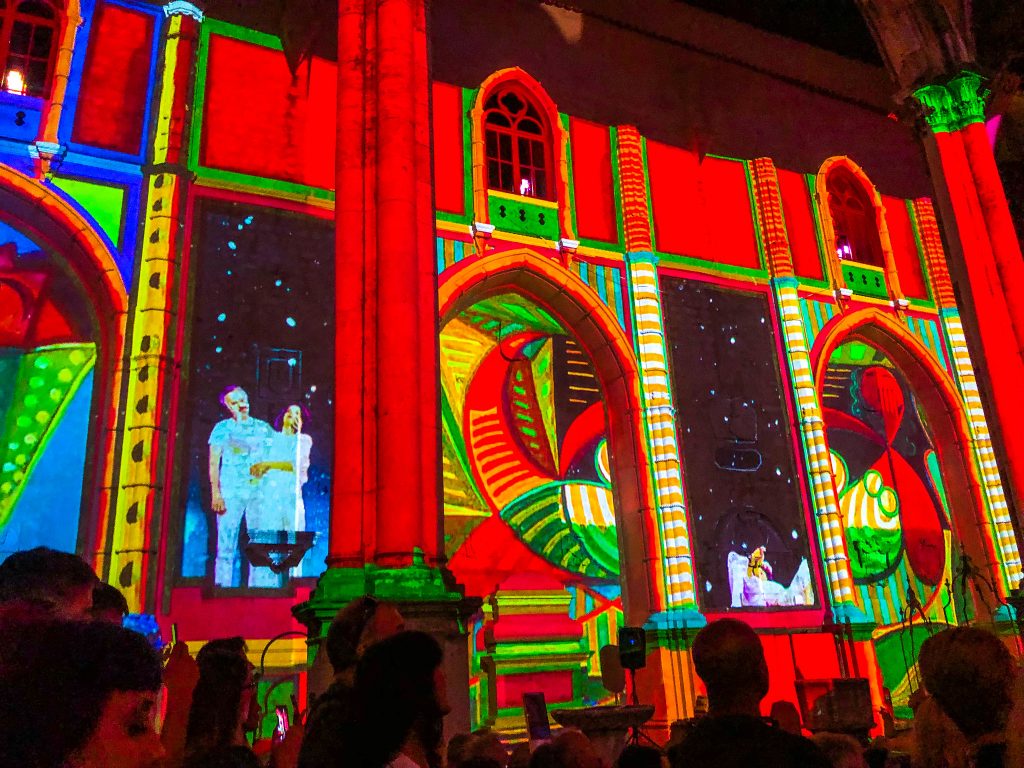
Images frame in the tiled archways around the church, and we see black and white pictures from the fall of the dictatorship of 25 April 1974. This event was called the ‘carnation revolution’. The coup was organized by the Armed Forces and military offers who opposed the regime. As they gathered, the civilians of the city joined them since they knew finally there was no army to resist them, and this was their moment to overthrow the autocratic regime.
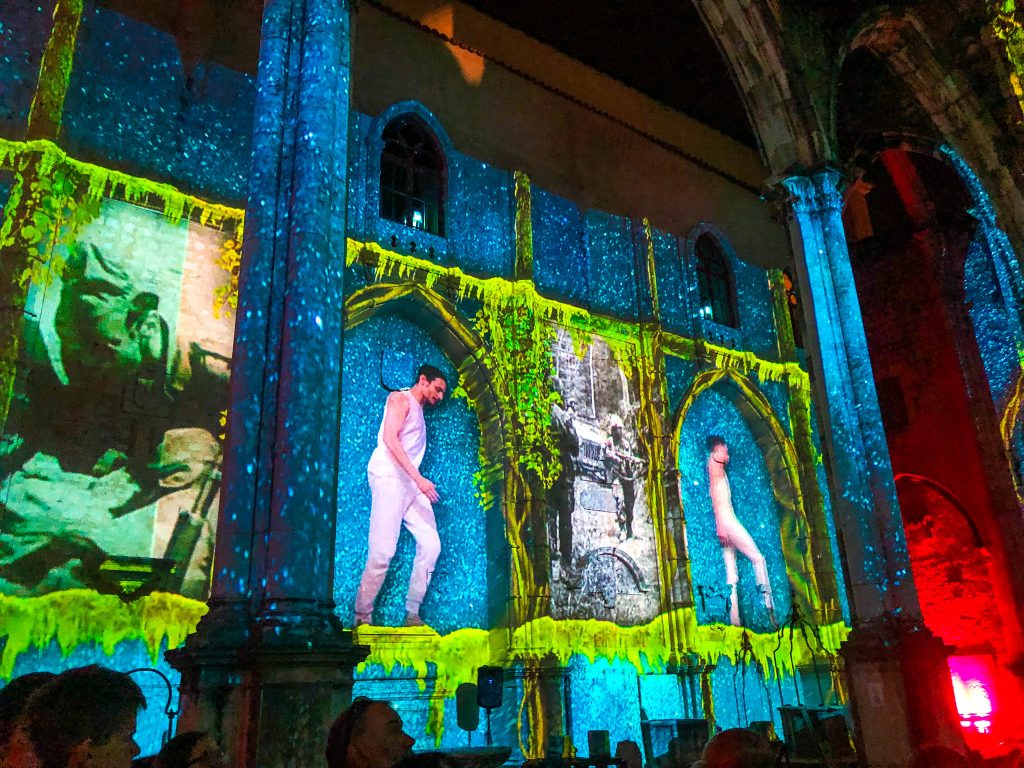
What is surprising about this revolution is that not a single shot was fired. An unsuspecting hero in the revolution was a simple restaurant worker, Celeste Caeiro who came out to give red carnations to the soldiers to celebrate their freeing of the Portuguese people from the dictator. Other women followed her lead, placing carnation into the muzzles of guns and onto the soldier’s uniforms. Projected onto all the walls of the convent are falling carnations, stacking up as high as the walls themselves until everyone is buried under a bed of red flowers. The convent spirit is dressed in red in these scenes and performs a dance of freedom as the carnations fall around her. This was one of my favourite visuals of the entire performance.
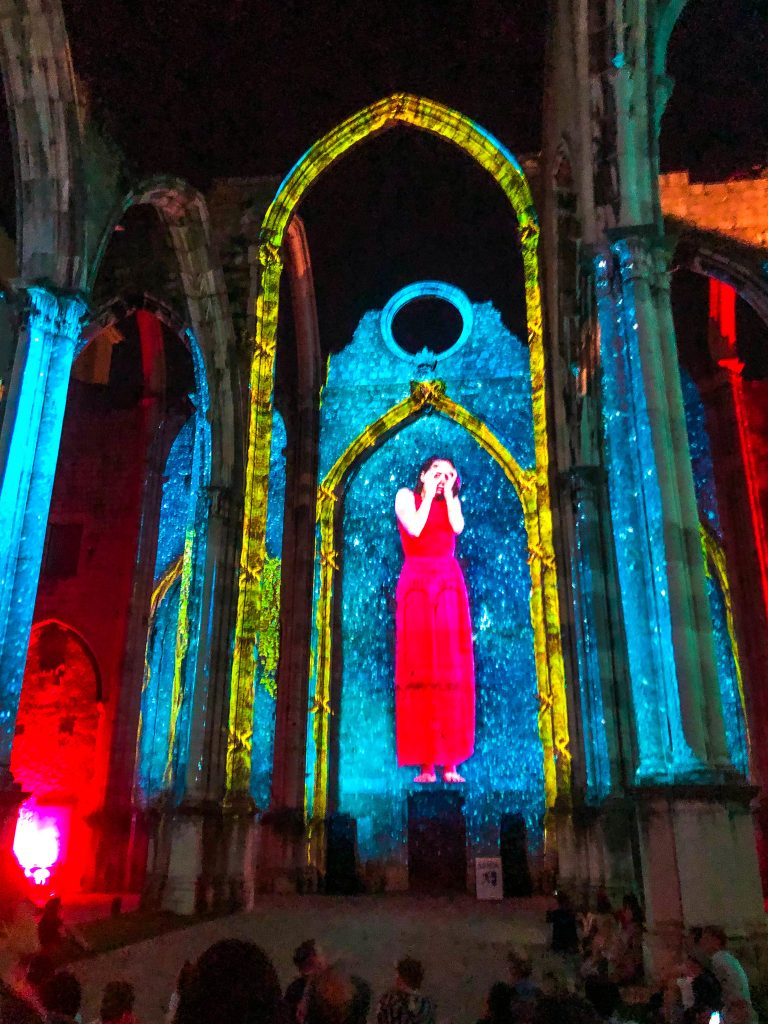
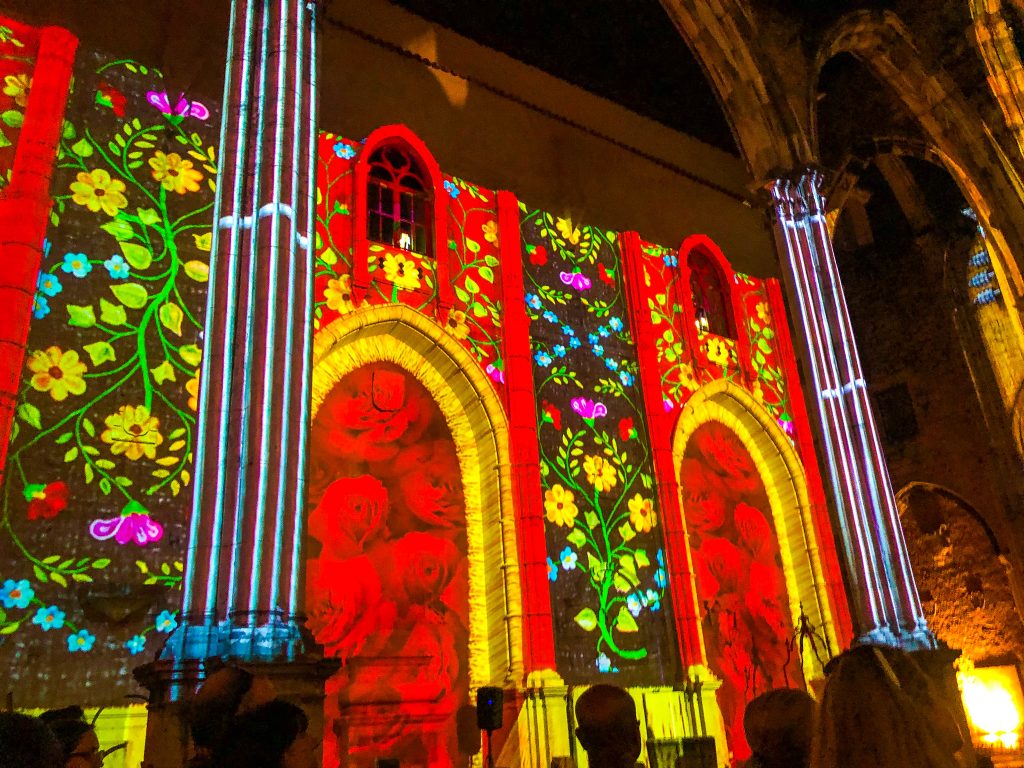
To end the show, the projections featured urban artists, graffiti and street art were sprayed across the convent walls. The visuals featured images from artists such as Add Fuel, Daniel Eime, the Super Van by Vanessa Teodoro and Alexandre Farto aka Vhils. These aren’t like paintings you’ll always see hanging in fancy art galleries. Instead, these are examples of art which everyone in Lisbon can view every day on their walk to work or passing by on the streetcar. There is no cost of admission, only a sense of discovery which will help you find these beautiful works of art. There is something extraordinary about elevating this kind of artwork, giving it credence in the show featuring mostly “high” art, which I found refreshing and inspiring.
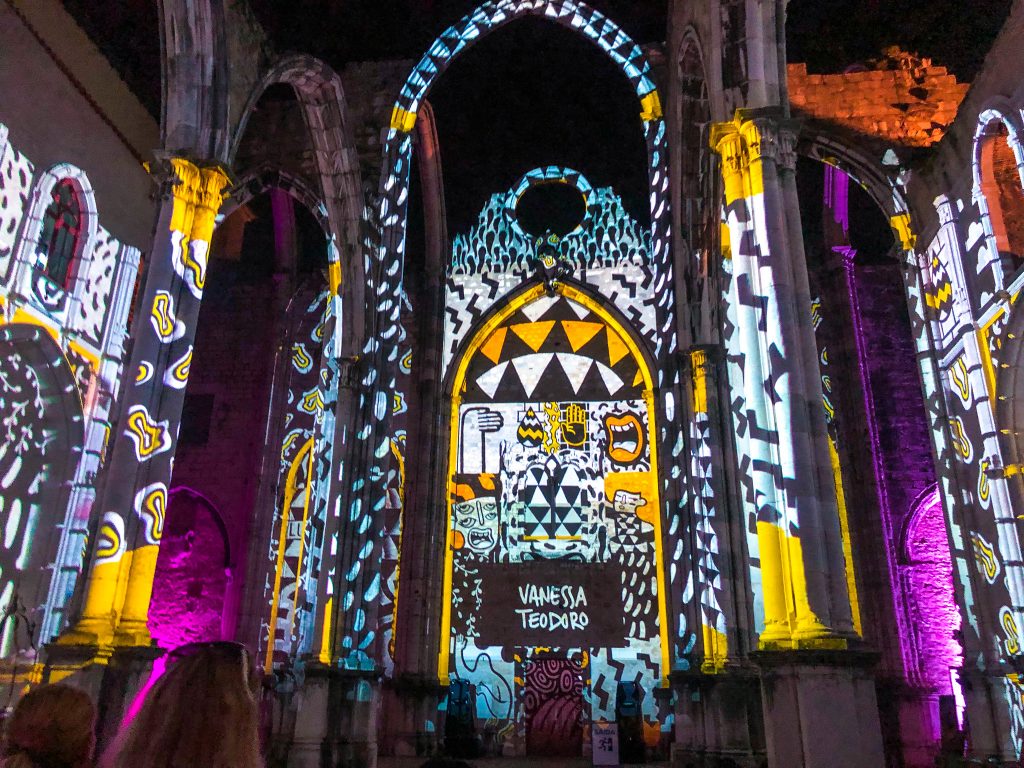
The show ends with one last beautiful Fado song. As the lights go down, all you’re left with is the most incredible view up to the stars, framed by those iconic Gothic columns and archways. The music continues to play as you exit, and we literally danced our way out the door!
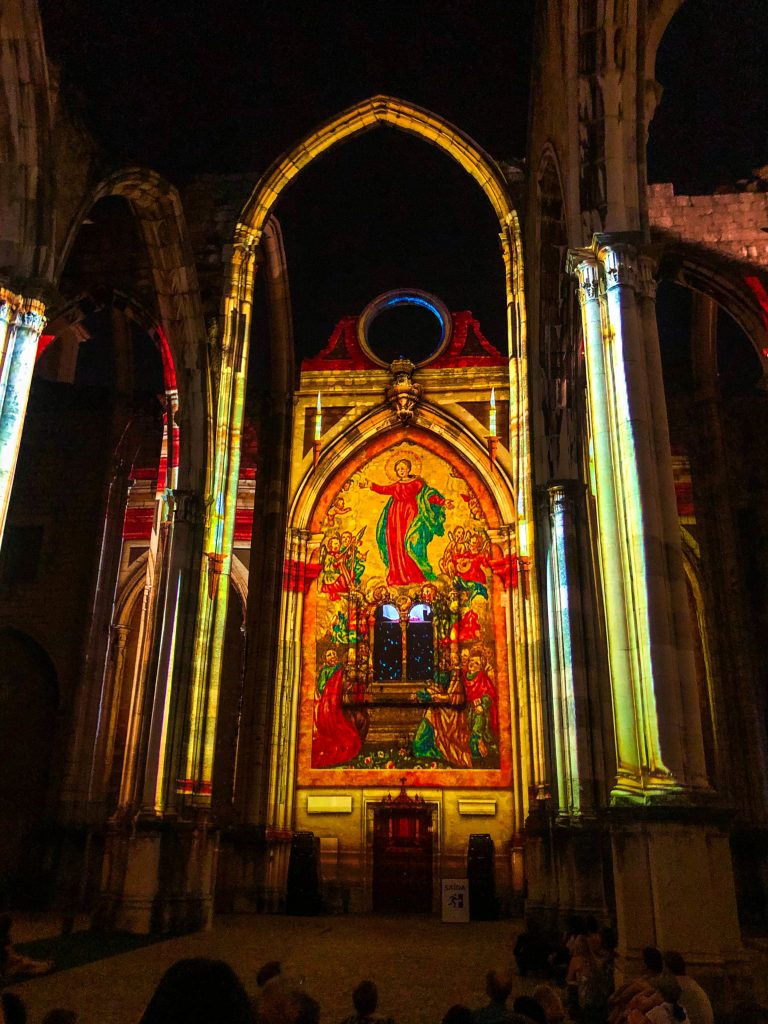
If you happen to be in Lisbon while this show takes place next year, it is really worth checking out. I thought it was incredibly fun, funky and the perfect way to spend a warm, summer evening. If you don’t know anything about Lisbon’s past, it’s a fantastic history lesson! What you’ll learn will help contextualize so much of what you’ll see around Lisbon during the rest of your stay. Don’t miss it if you get the chance!
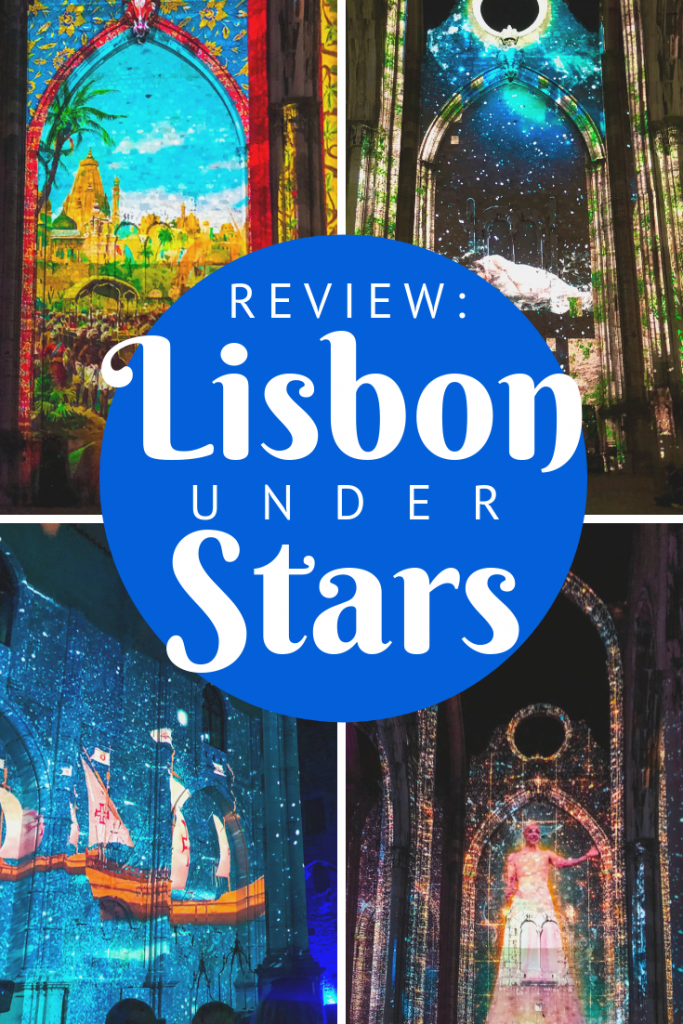
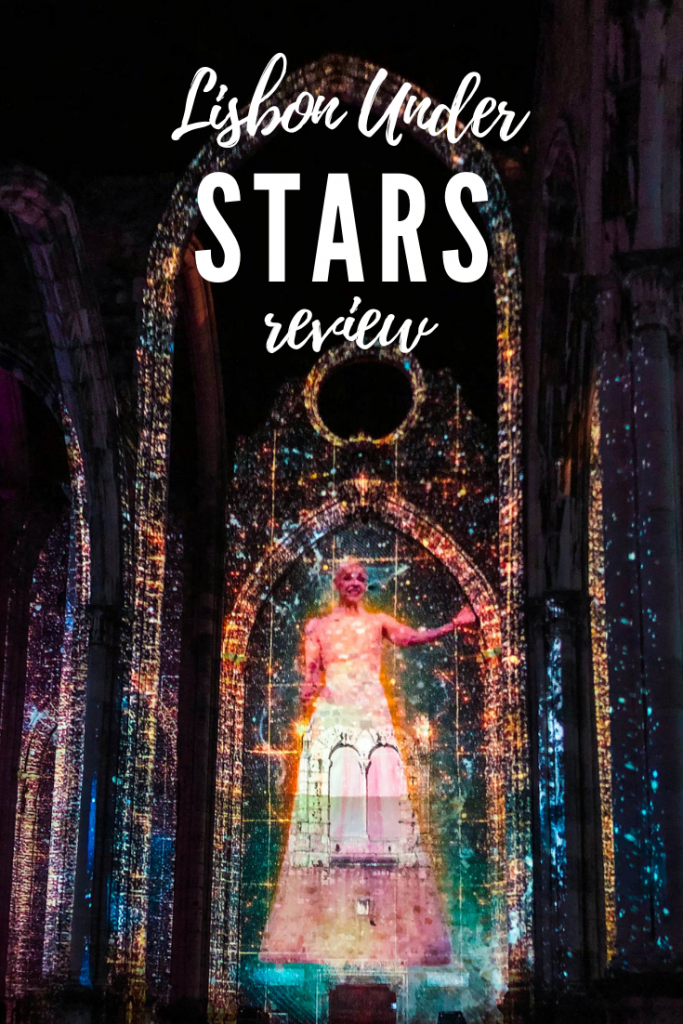
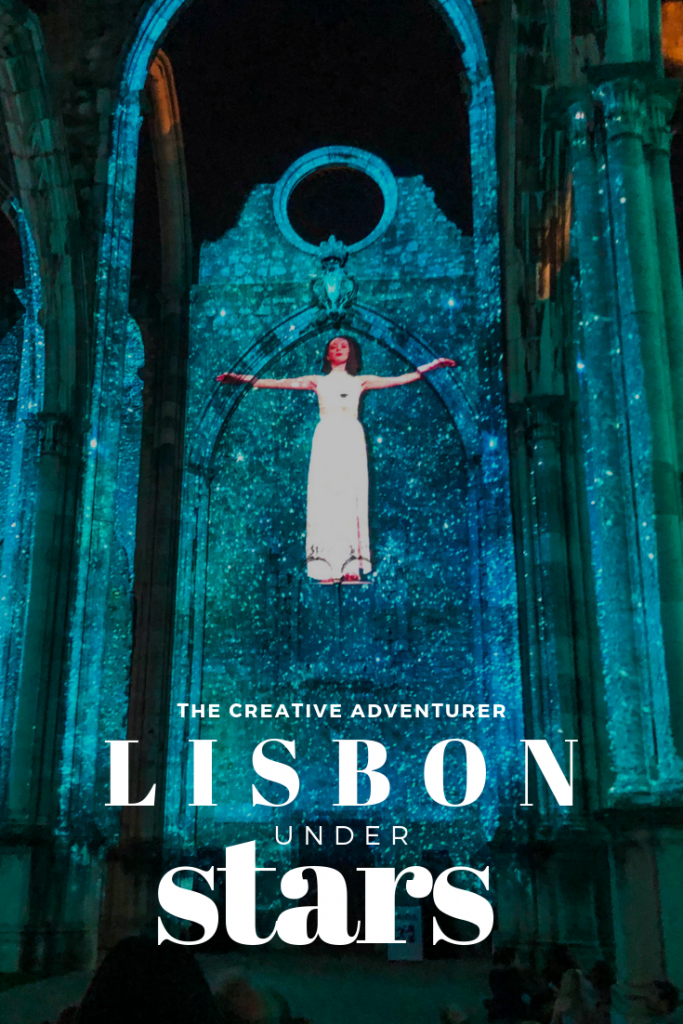


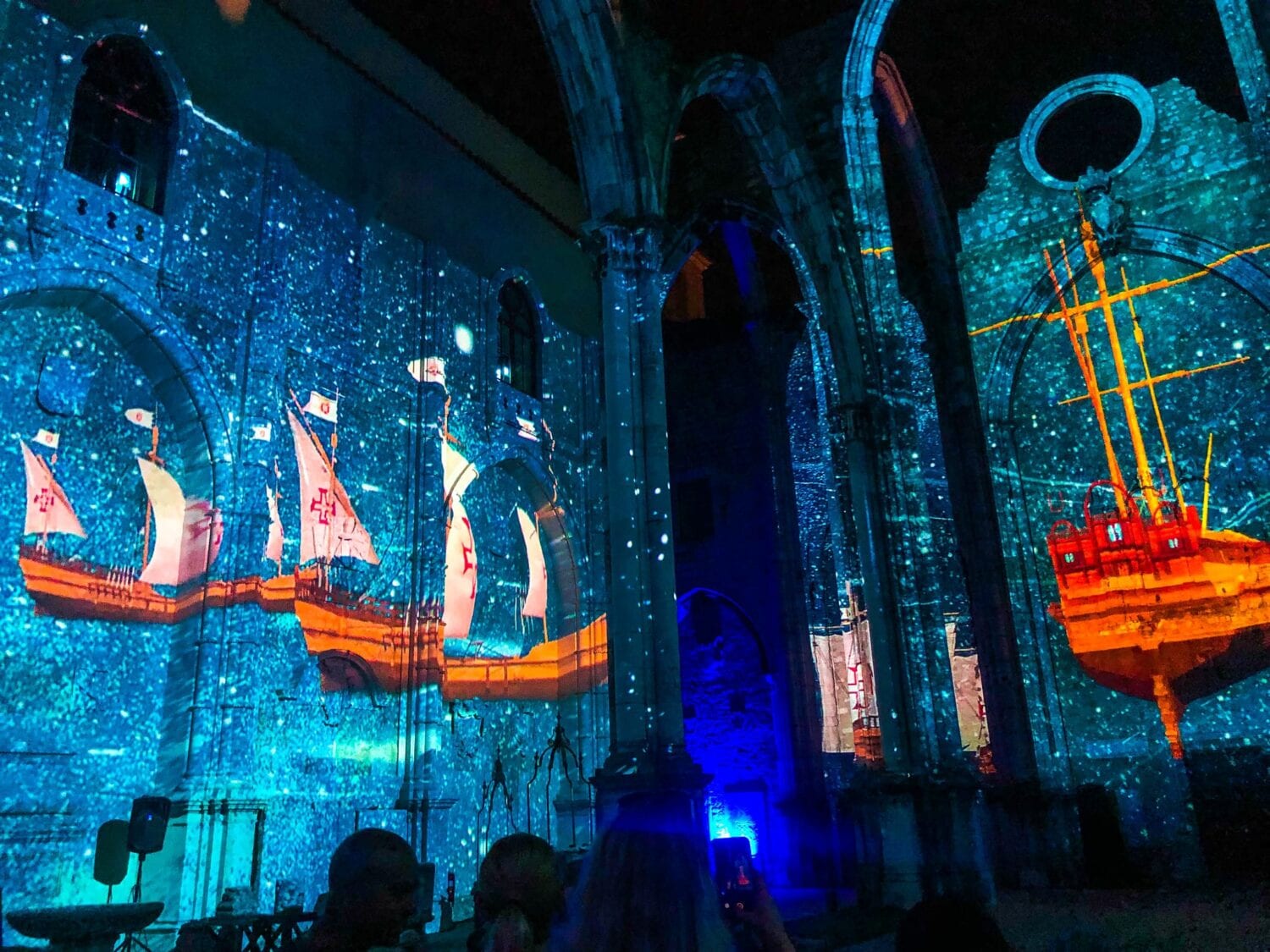
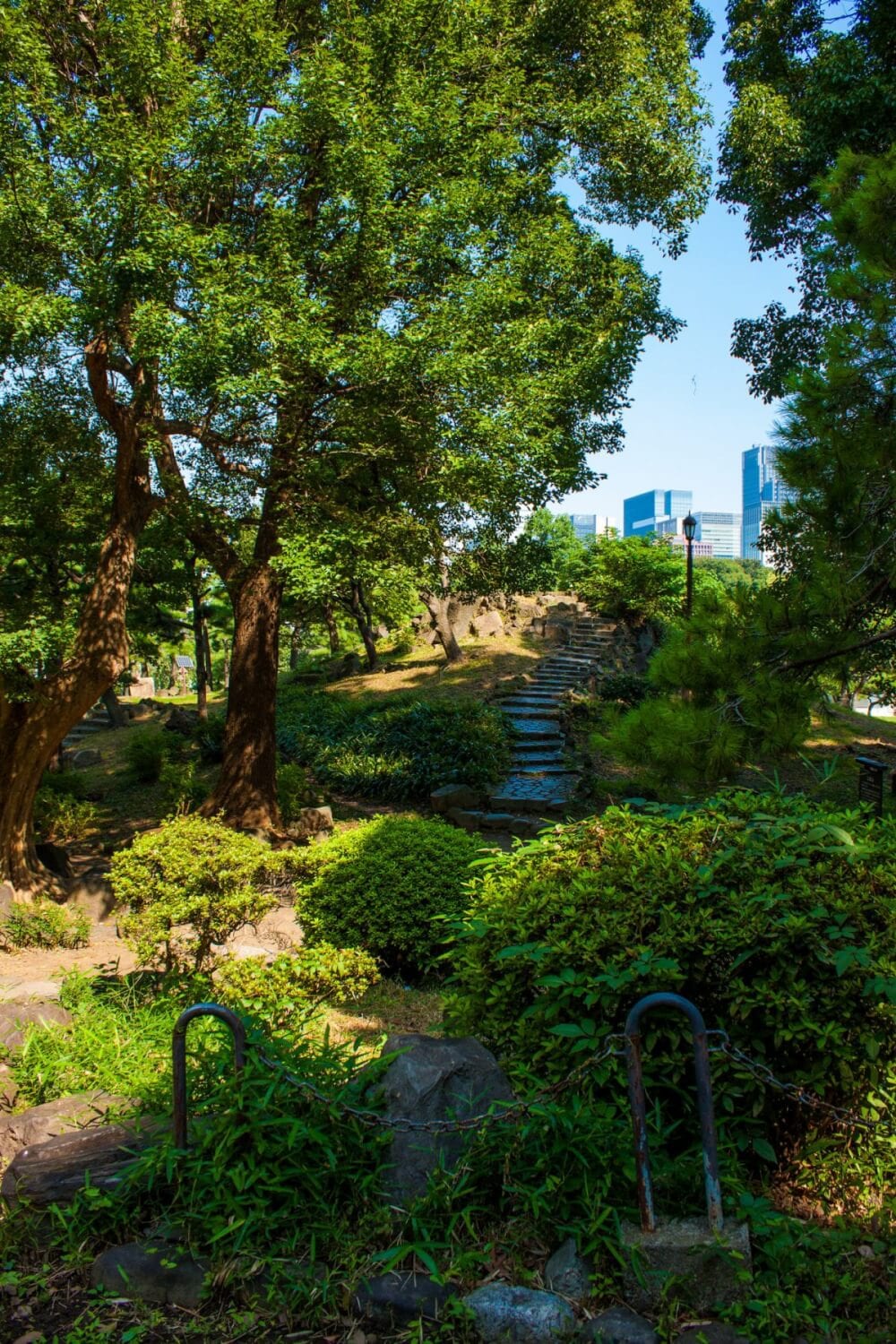
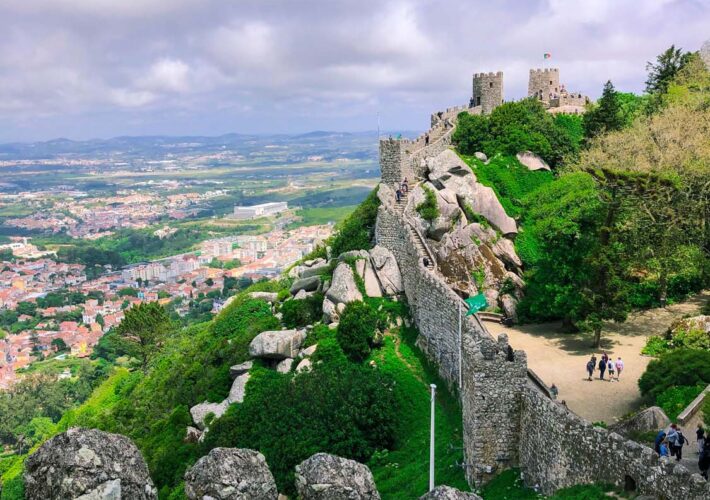
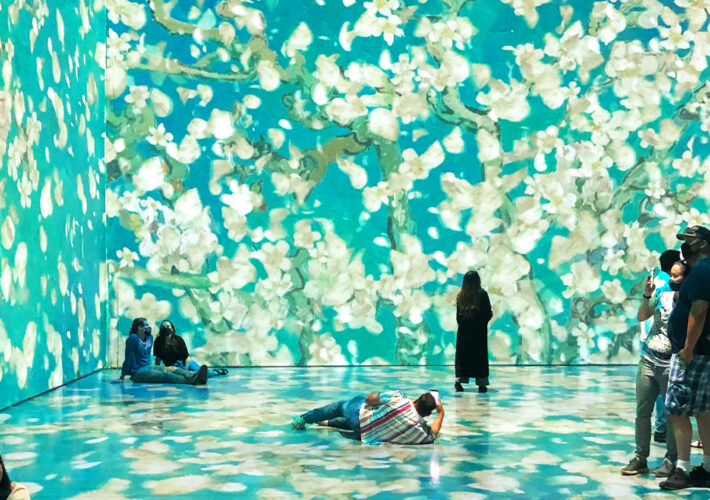
Leave a Comment